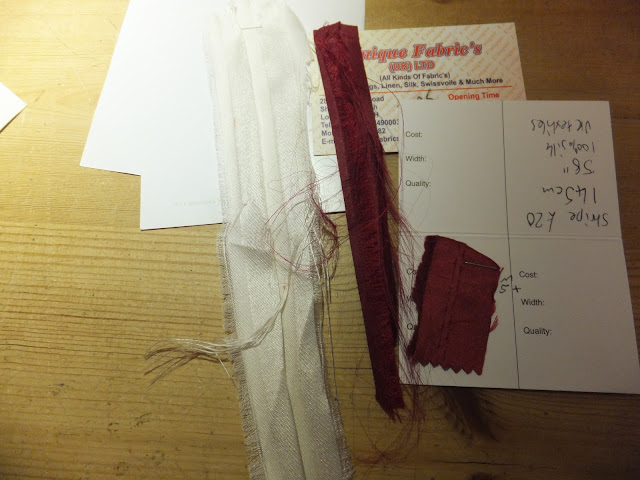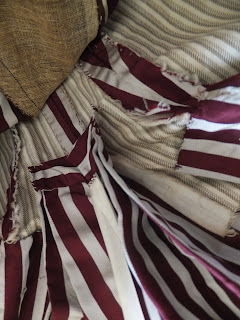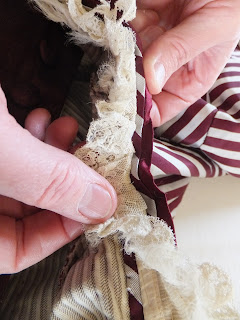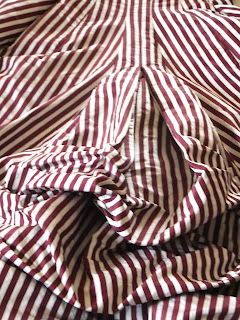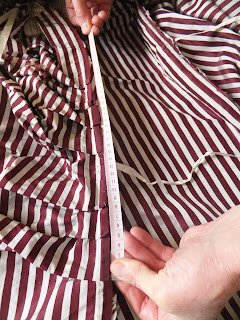So this week and the next are all about constructing the dress and all the finishes that go with it.
I wont be giving a blow by blow account but I do have some in progress shots and its nice to take the time to have a think about how things are going and a forum to admit my mistakes. I am enjoying working from home as I have a good set up here with everything that I need. I did start the term by going into uni everyday right up until I had drawn out my patterns and made the toile, but space was a constant struggle and so I decided I would benefit more from my own space. This has limited the amount of tutor contact I am receiving but I have/ will be meeting up with my tutors once a week to discuss the way things are progressing.
A Long Hard Think About Work Ethics
The end of the project is in sight now and I am starting to feel the pressure mounting, this is mostly due to all the other demands on my time; I am teaching/assisting twice a week in a secondary school as I am thinking about undertaking a teaching qualification next year to teach secondary D&T textiles, and I am also working as a seamstress in the bridal shop one morning a week. I also have Roisin's birthday this week and I am making the cake for the wedding next week.
Whilst a lot of this was scheduled into my workplan at the beginning of the project, the teaching is a new addition(which I have not added to the plan!) so I am finding it harder to keep on top of everything. My solution is to ask Rebecca for an extra few days and hand in on the Friday afternoon instead of Monday morning of the 3rd, although I will still have my presentation on the Monday.
Also, I have had to cancel Roisin's party and the visit this weekend by my friend and her children because I have had to be realistic about what I can achieve with my time, I don't feel too bad, in fact I feel quite liberated, in previous units I have just let the pressure pile on and on without being able to say "no". Roisin was okay, I bribed her with money instead of a party, so she was happy and I was slightly relieved, what a shame I did not have this epiphany before I offered to take on the responsibility of making a wedding cake the week before hand in.
I find with my work I am always thinking through what I have left to do and how I am going to get whats needs to be done out of the way in time. I know I have enough time to finish the dress and to finish it well. It has been a huge challenge to undertake the JAA in this unit, but I have always known that it is not beyond my limitations and when I work, especially when it is something I enjoy I give it 110% effort.
Its worth pointing out that I am not rushing the construction-even though I have a lot to do. I have not invested all this time and money just to produce something sub-standard because I wanted to cram it into a unit to suit myself. On the contrary, I felt I was able to tackle this project now and that it would move me on even further for the next unit. I have already agreed with my tutors that I will complete the 18 hand sewn buttons and button holes after hand in (but before entry to the competition in the Summer) as there just is not time to complete them in this unit. I will be producing some samples however.
A point in case, is the organdie and lace pleated frill/dust catcher at the bottom of the dress. I had completed it earlier this week- I had tea died the organdie, which was white to begin with, and cut and hand pressed all the pleats. It took a whole evenings worth of work to complete. At some point, I realised it was not right as I went back to look at my photos of the original and I could see the proportion of the pleats to the band was wrong (pleats were too short) and the tea dye had turned the organdie a funny colour with a slight purple hue, instead of the cream I was looking for.
Regardless of the time I spent making it, I knew I was going to re-do it. No rush jobs. So I re-made the piece and dyed it with coffee, cut new organdie and got it right, and now it looks superb.
1st attempt:
2nd attempt:
Original:
I think there is a moral to the story in here somewhere, not least that I have realised the importance of prioritising my time and trying to balance out work/life, and that it is okay to be a little selfish sometimes with regard to my time.
I'm a hard worker, I will go the extra mile to get something right, or work very long hours to produce results and I think this is reflected in the quality of my work. I love my work, and I really am enjoying making something of my own choosing with my own challenges and I am finding that I am very capable of working independently, away from uni, which is exactly where I should be at this point in my degree.
Under Construction
As promised, here are some photos of some of the construction work to the dress, every process takes a lot of time and patience and I am constantly referring back to my research and photos I took of the original dress.

































